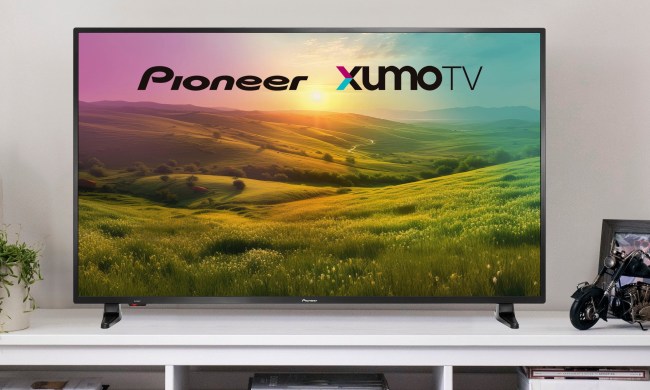- Excellent image quality
- plenty of features
- High Price
Summary
I can safely say that if you can afford the screen you should buy it. By affording I mean the MSRP on this puppy is US$20,000. I will tell you that you can spend literally between 10 and 15 minutes on the Internet, and find a great deal. I have seen it for as low as $8999. Sales come and go, but you can consistently see this screen for around $11,000.
So far it has been worth every penny. Every client we bring in the room has something good to say about that screen. It has helped us sell products and have a raging good time. Overall, it has paid for itself in the business it has attracted, because multimedia and CBT look real good up there too.
Introduction
If you have ever seen one of these babies at Best Buy or Circuit City, you know what I mean when I say it will truly make you cry when you have to walk out of the store without one. This 50-inch beauty provides a super detailed, unprecedented view into the electronic window created by any high-end signal sent through its many inputs.
The Motive
Let’s start at the beginning; my team needed a high definition display that could be used in a variety of different ways. I needed to be able to hook up Desktop Computers, Laptops, VHS, DV, Beta decks and DVD players. I also wanted to hook up a Playstation2. We work hard and we play hard.
With that in mind we started searching the Internet for a product that could do all these things. I will not go into detail about the other products we found that could generally show a moving picture on a 50-inch screen. Most of them just didn’t have the number of inputs we needed. So we’ll center on the reasons we picked the Pioneer.
The reason we picked the Pioneer 505HD was that the number of inputs was just right for what we wanted. Of course, the 50 inch high definition plasma display had something to do with it also. The huge, crisp, luminescent display still sends shivers up my spine every time I turn the thing on.
The Screen
The unit has a 50-inch screen, which takes up most of the console. It’s only 4 inches in depth. Have I mentioned the High definition part? Pioneer uses what they call Pioneer Automatic Format Converter (PAFC). The PAFC basically converts the analog video signal to digital format on the fly. As mentioned in the specs below; this screen has a 160×160 degree viewing angle. As far as my eyes can tell there is no weird streaking, color dithering, banding or jaggies.
The Resolution
The resolution is incredible. XGA resolution is native 16:9 aspect ratio coming in at a nice 1280×768 75Hz. Using the aforementioned PAFC technology; the 505hd automatically converts any signal to 768 display using 16 million colors at .858mm x .808mm pixel pitch.
Not surprisingly, the 505hd produces a very crisp color correct picture. To tweak the color; Pioneer allows you to adjust the “color temperature”. The only thing I found lacking in color was the black. The blacks were not true blacks; they were a dark grey. The reds come close, but still retains an orange/red blend.
The Installation
The screen can be wall mounted or it can stand on a tabletop. Let me warn you now though both of these mounting kits are sold separately. The price of these accessories depends on what dealer you go to. Keep in mind though that you must choose one of the mounts. Wall or table; because there is no other way to stand it up. If you do not buy one or the other, your only recourse is to lay it up against the wall. It is not recommended you build it inside a wall because of the heat generated by this thing. If you decide to get the wall mount have a friend with you. The screen itself is a heavy 94 pounds. That means you must mount directly to the stud or it will rip your wall down.
The Hookup
Installation of all my gear was a snap. As you can see in the picture our normal setup includes a presentation laptop, and for sound, a Bose home theater system. The black box underneath allows us to pipe in both video and sound from our digital studio next door. As discussed in the input section, all the inputs are located on the bottom of the screen. It is very easy to hook up video and/or audio cables to the 505hd.
Inputs
Let’s talk inputs. The 505HP has 4 input panels. The input 1 panel has your standard Composite video input and an S-Video input. These can be used to hookup any standard video equipment. This includes a DVD Player, VCR, Cable box, DV Deck, VHS Deck, Beta Deck, Playstation 2, etc… The S-Video port can handle Video Cameras, some laptops, plus a variety of other specialized equipment.
Input 2 is comprised of your standard Yellow/Red/White dedicated component input. As you may know if you have ever hooked up ANY home theater, these ports will do you just fine if you want to hook up the satellite system plus the surround system to this gem of a screen.
Input 3 is a collection of BNC connectors used to hook equipment that uses RGB Component jacks. These can include computers, high end DVD players, a Variety of Video Decks. This input set is usually known as YRB. For those of you in the business; you know what I am talking about.
Input 4 is a standard D-Sub connector. This is used to hook a desktop computer or laptop to the screen using a standard D-sub connector (a.k.a. a monitor cable).
Have you noticed that this screen is lacking DVI connectors; yes, you are a very astute reader. NO the pioneer does not have a DVI input, but once you hook up your computer to the 505hd (using the D-Sub connection); you will not be sweating this fact anymore. We have a computer hooked up to this 24 hours a day. Our primary use of this screen is for the presentation and selling of our product, which happens to be high-end video, 3D animation, and multimedia. It is the best computer screen I have ever seen. Crisp detail, no dither, fast DV, and tight fast video game play makes me love this screen.
The operations panel is located on the right hand side of the screen. You use this panel to access the menu selections as well as change inputs on the fly.
The Little Stuff
I was surprised to find that the remote was nothing to write home about. It is a standard black brick with no special features. Sure it allows you full control over the screen and all its’ functions, but it’s IR, not RF, which means you have to be in line of site to operate it. Also, no cool jog wheels, no touch screen display, nothing on the same high-end plateau as the screen itself.
Now for the fun part… when we hookup the Playstation 2 to this screen it is like stepping into another world. Playing GT3 just isn’t the same experience on any other screen. Of course, the Bose surround sound home theater system helps as well, but you know what I mean.
Money
I can safely say that if you can afford the screen you should buy it. By affording I mean the MSRP on this puppy is US$20,000. I will tell you that you can spend literally between 10 and 15 minutes on the Internet, and find a great deal. I have seen it for as low as $8999. Sales come and go, but you can consistently see this screen for around $11,000.
So far it has been worth every penny. Every client we bring in the room has something good to say about that screen. It has helped us sell products and have a raging good time. Overall, it has paid for itself in the business it has attracted, because multimedia and CBT look real good up there too.




